Financial Analysis of ABC Company: Ratio Interpretation and Solutions
VerifiedAdded on 2022/12/02
|6
|1057
|468
Report
AI Summary
This report presents a financial ratio analysis of ABC Company, evaluating its performance based on provided financial data. The analysis includes the calculation and interpretation of key ratios such as the working capital ratio, accounts receivable collection period ratio, and debt ratio. The report assesses the company's liquidity, efficiency in collecting receivables, and its debt position. Each ratio is evaluated to determine if it indicates good or poor financial health, with explanations to support the findings. Furthermore, the report proposes solutions and strategies to improve the company's financial standing, even if the initial ratio appears acceptable. The ultimate goal is to provide actionable insights and recommendations for enhancing ABC Company's financial performance and stability. The assignment is a practical application of financial analysis principles, demonstrating an understanding of how to assess a company's financial position using key performance indicators.
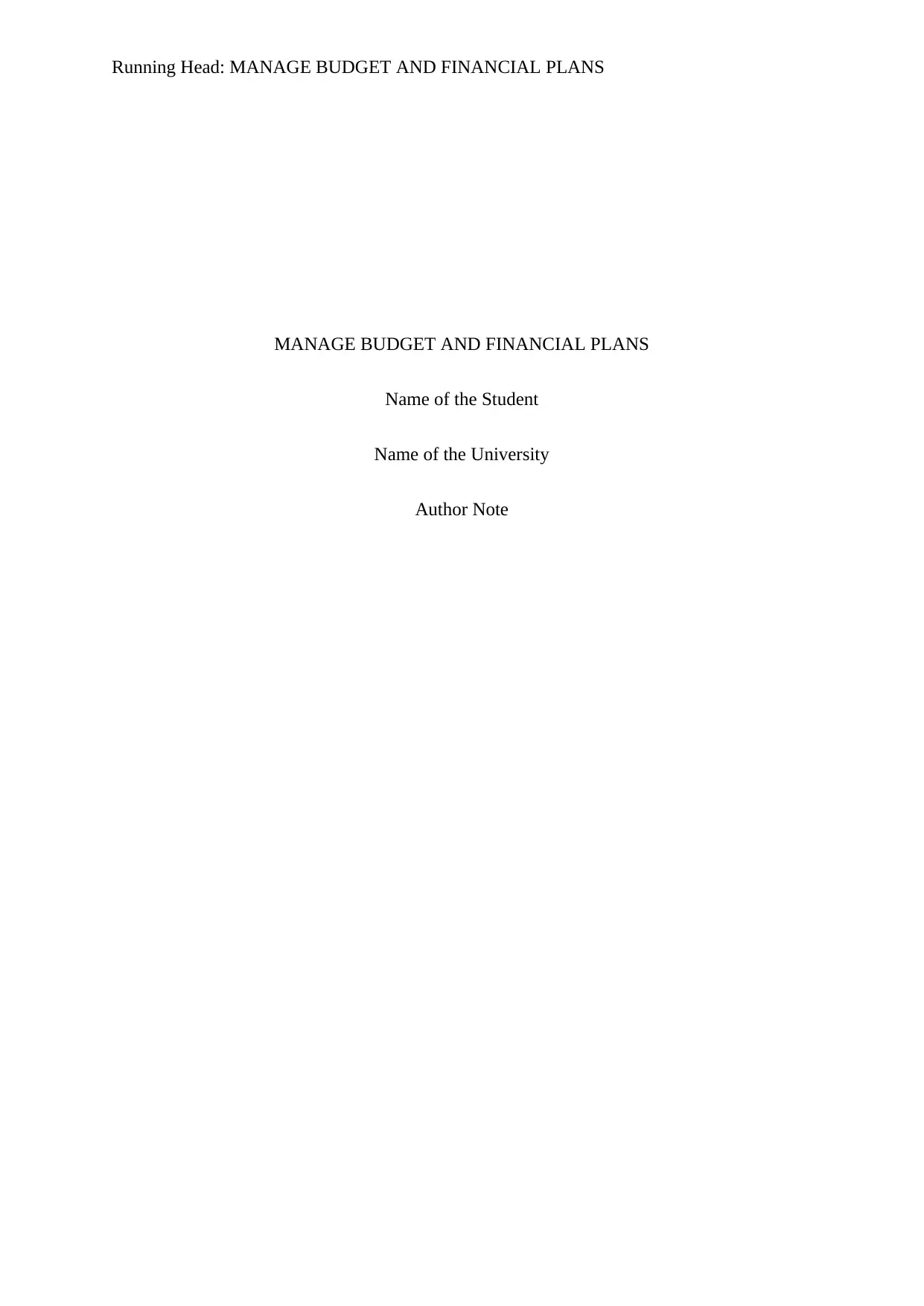
Running Head: MANAGE BUDGET AND FINANCIAL PLANS
MANAGE BUDGET AND FINANCIAL PLANS
Name of the Student
Name of the University
Author Note
MANAGE BUDGET AND FINANCIAL PLANS
Name of the Student
Name of the University
Author Note
Paraphrase This Document
Need a fresh take? Get an instant paraphrase of this document with our AI Paraphraser

1MANAGE BUDGET AND FINANCIAL PLANS
Table of Contents
Analysis of Ratios of ABC Company........................................................................................2
Working Capital Ratio...........................................................................................................2
Accounts Receivables Collection Period Ratio......................................................................2
Debt Ratio..............................................................................................................................3
Reference and Bibliography.......................................................................................................4
Table of Contents
Analysis of Ratios of ABC Company........................................................................................2
Working Capital Ratio...........................................................................................................2
Accounts Receivables Collection Period Ratio......................................................................2
Debt Ratio..............................................................................................................................3
Reference and Bibliography.......................................................................................................4
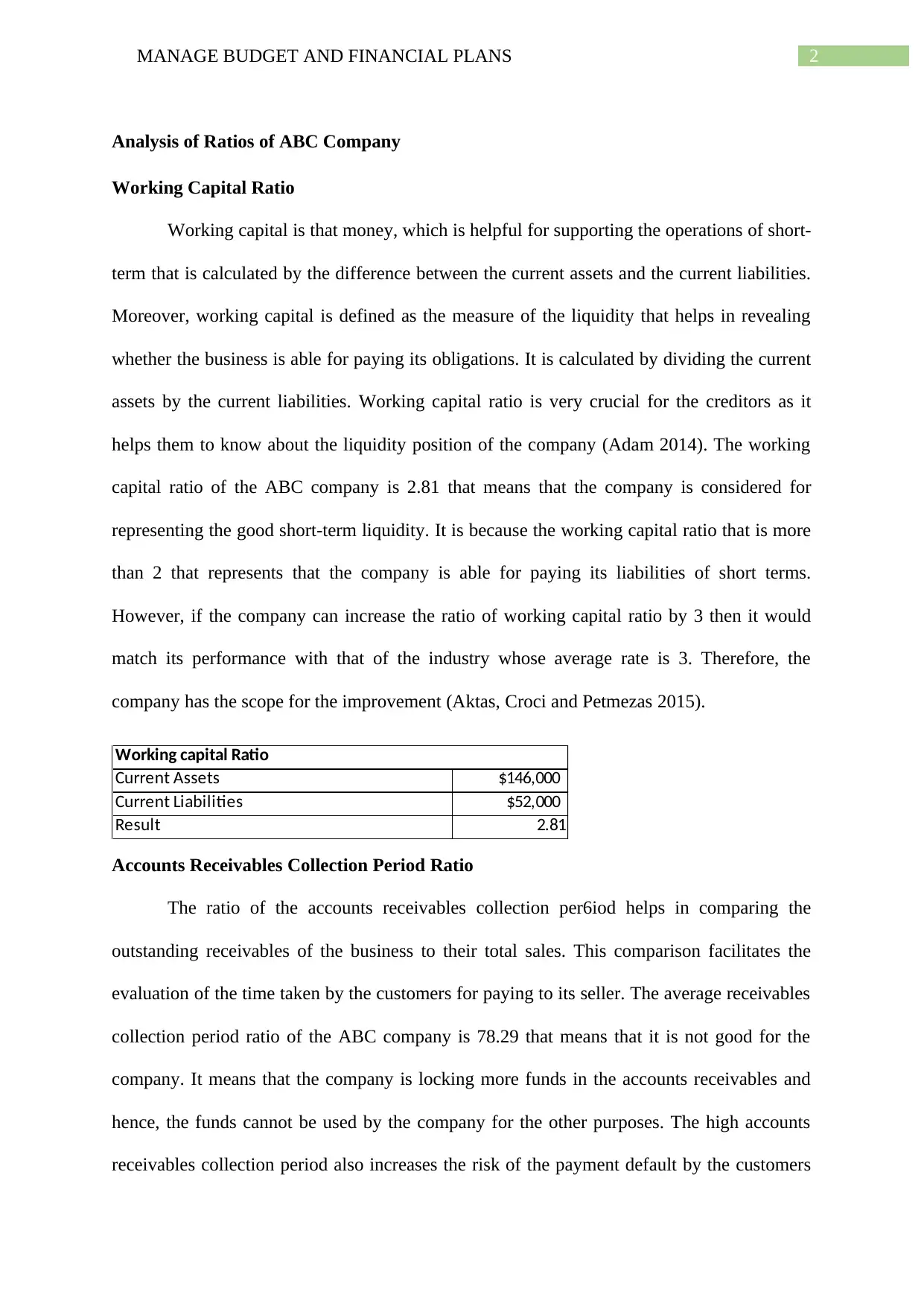
2MANAGE BUDGET AND FINANCIAL PLANS
Analysis of Ratios of ABC Company
Working Capital Ratio
Working capital is that money, which is helpful for supporting the operations of short-
term that is calculated by the difference between the current assets and the current liabilities.
Moreover, working capital is defined as the measure of the liquidity that helps in revealing
whether the business is able for paying its obligations. It is calculated by dividing the current
assets by the current liabilities. Working capital ratio is very crucial for the creditors as it
helps them to know about the liquidity position of the company (Adam 2014). The working
capital ratio of the ABC company is 2.81 that means that the company is considered for
representing the good short-term liquidity. It is because the working capital ratio that is more
than 2 that represents that the company is able for paying its liabilities of short terms.
However, if the company can increase the ratio of working capital ratio by 3 then it would
match its performance with that of the industry whose average rate is 3. Therefore, the
company has the scope for the improvement (Aktas, Croci and Petmezas 2015).
Current Assets $146,000
Current Liabilities $52,000
Result 2.81
Working capital Ratio
Accounts Receivables Collection Period Ratio
The ratio of the accounts receivables collection per6iod helps in comparing the
outstanding receivables of the business to their total sales. This comparison facilitates the
evaluation of the time taken by the customers for paying to its seller. The average receivables
collection period ratio of the ABC company is 78.29 that means that it is not good for the
company. It means that the company is locking more funds in the accounts receivables and
hence, the funds cannot be used by the company for the other purposes. The high accounts
receivables collection period also increases the risk of the payment default by the customers
Analysis of Ratios of ABC Company
Working Capital Ratio
Working capital is that money, which is helpful for supporting the operations of short-
term that is calculated by the difference between the current assets and the current liabilities.
Moreover, working capital is defined as the measure of the liquidity that helps in revealing
whether the business is able for paying its obligations. It is calculated by dividing the current
assets by the current liabilities. Working capital ratio is very crucial for the creditors as it
helps them to know about the liquidity position of the company (Adam 2014). The working
capital ratio of the ABC company is 2.81 that means that the company is considered for
representing the good short-term liquidity. It is because the working capital ratio that is more
than 2 that represents that the company is able for paying its liabilities of short terms.
However, if the company can increase the ratio of working capital ratio by 3 then it would
match its performance with that of the industry whose average rate is 3. Therefore, the
company has the scope for the improvement (Aktas, Croci and Petmezas 2015).
Current Assets $146,000
Current Liabilities $52,000
Result 2.81
Working capital Ratio
Accounts Receivables Collection Period Ratio
The ratio of the accounts receivables collection per6iod helps in comparing the
outstanding receivables of the business to their total sales. This comparison facilitates the
evaluation of the time taken by the customers for paying to its seller. The average receivables
collection period ratio of the ABC company is 78.29 that means that it is not good for the
company. It means that the company is locking more funds in the accounts receivables and
hence, the funds cannot be used by the company for the other purposes. The high accounts
receivables collection period also increases the risk of the payment default by the customers
⊘ This is a preview!⊘
Do you want full access?
Subscribe today to unlock all pages.

Trusted by 1+ million students worldwide
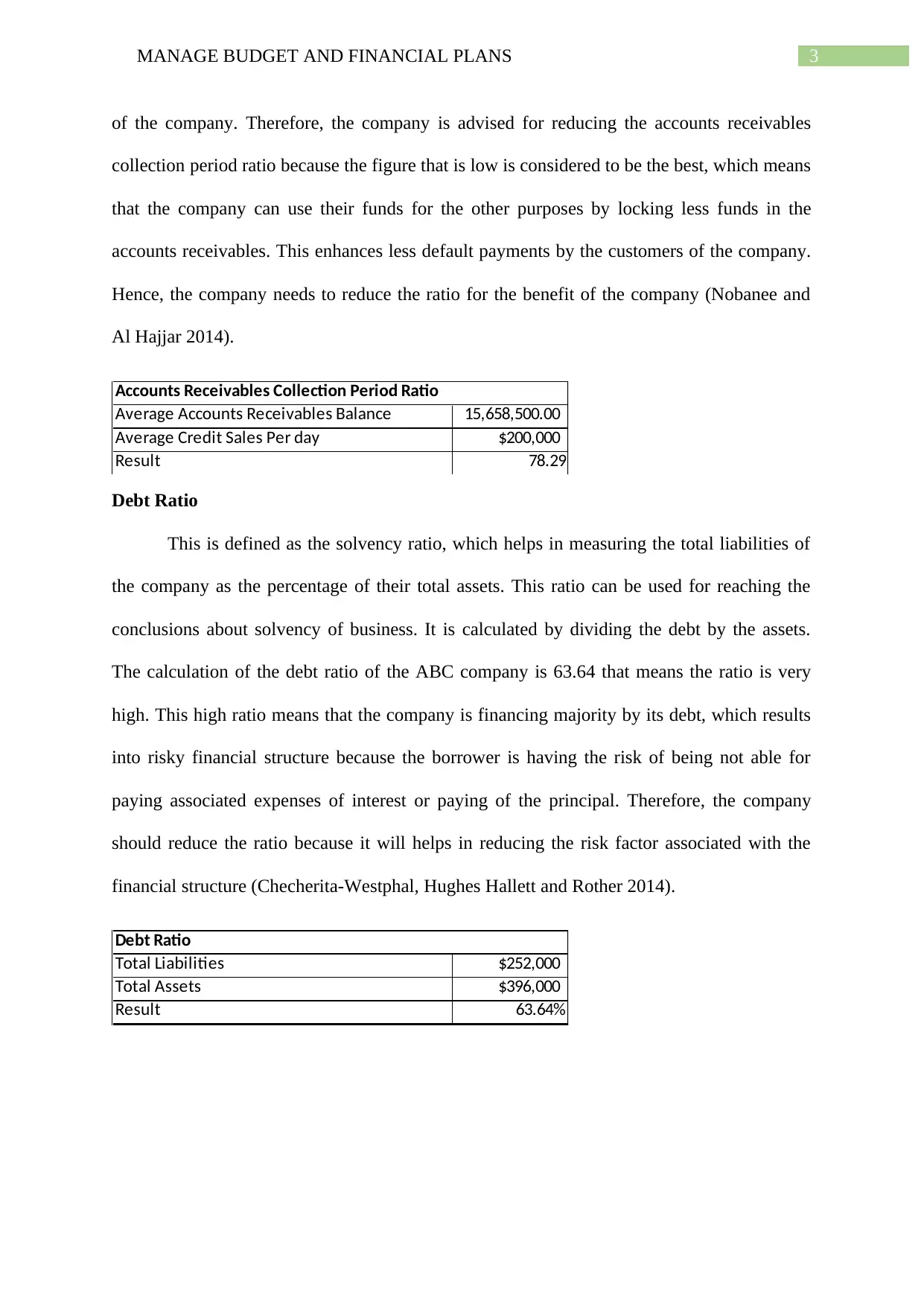
3MANAGE BUDGET AND FINANCIAL PLANS
of the company. Therefore, the company is advised for reducing the accounts receivables
collection period ratio because the figure that is low is considered to be the best, which means
that the company can use their funds for the other purposes by locking less funds in the
accounts receivables. This enhances less default payments by the customers of the company.
Hence, the company needs to reduce the ratio for the benefit of the company (Nobanee and
Al Hajjar 2014).
Average Accounts Receivables Balance 15,658,500.00
Average Credit Sales Per day $200,000
Result 78.29
Accounts Receivables Collection Period Ratio
Debt Ratio
This is defined as the solvency ratio, which helps in measuring the total liabilities of
the company as the percentage of their total assets. This ratio can be used for reaching the
conclusions about solvency of business. It is calculated by dividing the debt by the assets.
The calculation of the debt ratio of the ABC company is 63.64 that means the ratio is very
high. This high ratio means that the company is financing majority by its debt, which results
into risky financial structure because the borrower is having the risk of being not able for
paying associated expenses of interest or paying of the principal. Therefore, the company
should reduce the ratio because it will helps in reducing the risk factor associated with the
financial structure (Checherita-Westphal, Hughes Hallett and Rother 2014).
Total Liabilities $252,000
Total Assets $396,000
Result 63.64%
Debt Ratio
of the company. Therefore, the company is advised for reducing the accounts receivables
collection period ratio because the figure that is low is considered to be the best, which means
that the company can use their funds for the other purposes by locking less funds in the
accounts receivables. This enhances less default payments by the customers of the company.
Hence, the company needs to reduce the ratio for the benefit of the company (Nobanee and
Al Hajjar 2014).
Average Accounts Receivables Balance 15,658,500.00
Average Credit Sales Per day $200,000
Result 78.29
Accounts Receivables Collection Period Ratio
Debt Ratio
This is defined as the solvency ratio, which helps in measuring the total liabilities of
the company as the percentage of their total assets. This ratio can be used for reaching the
conclusions about solvency of business. It is calculated by dividing the debt by the assets.
The calculation of the debt ratio of the ABC company is 63.64 that means the ratio is very
high. This high ratio means that the company is financing majority by its debt, which results
into risky financial structure because the borrower is having the risk of being not able for
paying associated expenses of interest or paying of the principal. Therefore, the company
should reduce the ratio because it will helps in reducing the risk factor associated with the
financial structure (Checherita-Westphal, Hughes Hallett and Rother 2014).
Total Liabilities $252,000
Total Assets $396,000
Result 63.64%
Debt Ratio
Paraphrase This Document
Need a fresh take? Get an instant paraphrase of this document with our AI Paraphraser
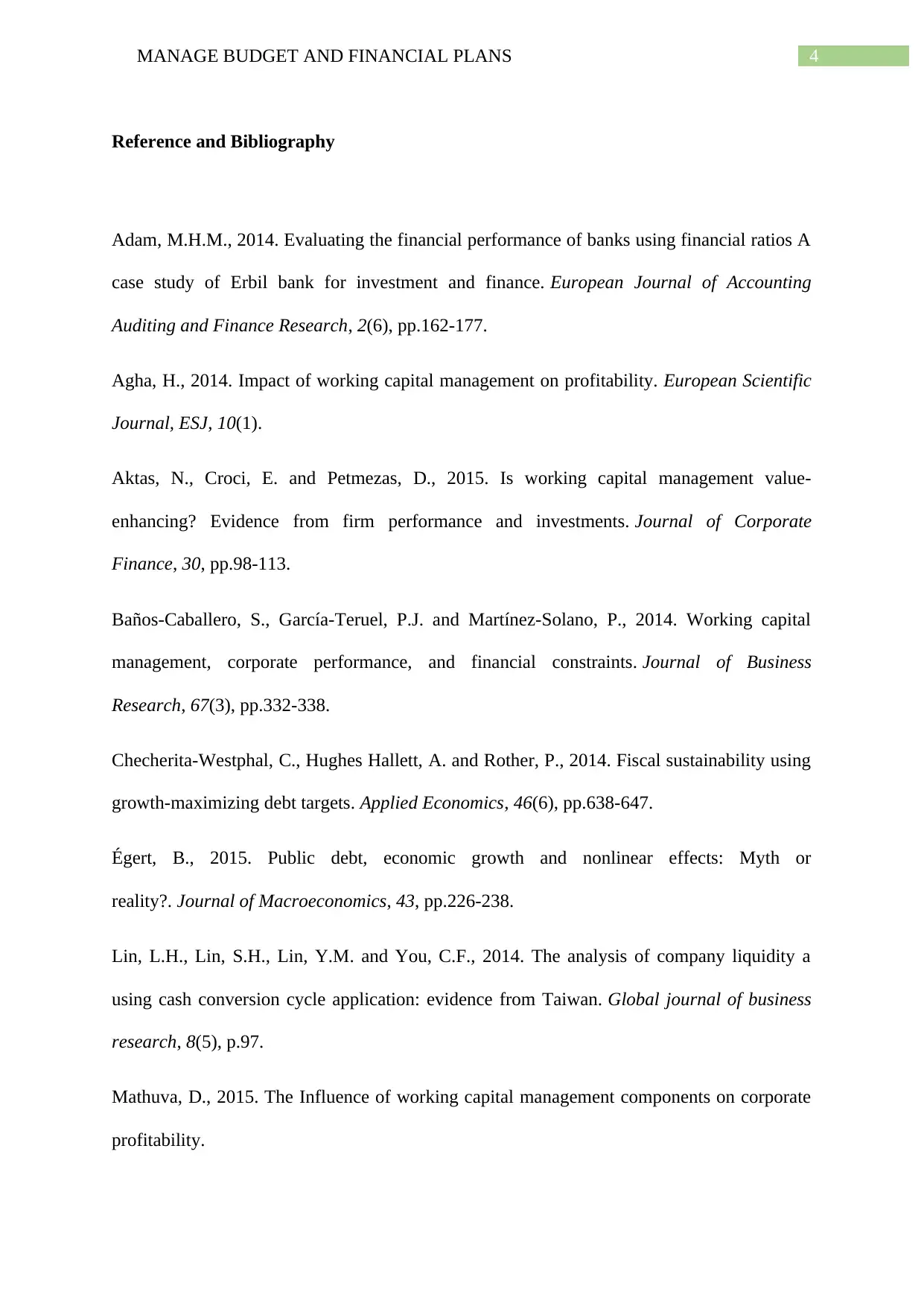
4MANAGE BUDGET AND FINANCIAL PLANS
Reference and Bibliography
Adam, M.H.M., 2014. Evaluating the financial performance of banks using financial ratios A
case study of Erbil bank for investment and finance. European Journal of Accounting
Auditing and Finance Research, 2(6), pp.162-177.
Agha, H., 2014. Impact of working capital management on profitability. European Scientific
Journal, ESJ, 10(1).
Aktas, N., Croci, E. and Petmezas, D., 2015. Is working capital management value-
enhancing? Evidence from firm performance and investments. Journal of Corporate
Finance, 30, pp.98-113.
Baños-Caballero, S., García-Teruel, P.J. and Martínez-Solano, P., 2014. Working capital
management, corporate performance, and financial constraints. Journal of Business
Research, 67(3), pp.332-338.
Checherita-Westphal, C., Hughes Hallett, A. and Rother, P., 2014. Fiscal sustainability using
growth-maximizing debt targets. Applied Economics, 46(6), pp.638-647.
Égert, B., 2015. Public debt, economic growth and nonlinear effects: Myth or
reality?. Journal of Macroeconomics, 43, pp.226-238.
Lin, L.H., Lin, S.H., Lin, Y.M. and You, C.F., 2014. The analysis of company liquidity a
using cash conversion cycle application: evidence from Taiwan. Global journal of business
research, 8(5), p.97.
Mathuva, D., 2015. The Influence of working capital management components on corporate
profitability.
Reference and Bibliography
Adam, M.H.M., 2014. Evaluating the financial performance of banks using financial ratios A
case study of Erbil bank for investment and finance. European Journal of Accounting
Auditing and Finance Research, 2(6), pp.162-177.
Agha, H., 2014. Impact of working capital management on profitability. European Scientific
Journal, ESJ, 10(1).
Aktas, N., Croci, E. and Petmezas, D., 2015. Is working capital management value-
enhancing? Evidence from firm performance and investments. Journal of Corporate
Finance, 30, pp.98-113.
Baños-Caballero, S., García-Teruel, P.J. and Martínez-Solano, P., 2014. Working capital
management, corporate performance, and financial constraints. Journal of Business
Research, 67(3), pp.332-338.
Checherita-Westphal, C., Hughes Hallett, A. and Rother, P., 2014. Fiscal sustainability using
growth-maximizing debt targets. Applied Economics, 46(6), pp.638-647.
Égert, B., 2015. Public debt, economic growth and nonlinear effects: Myth or
reality?. Journal of Macroeconomics, 43, pp.226-238.
Lin, L.H., Lin, S.H., Lin, Y.M. and You, C.F., 2014. The analysis of company liquidity a
using cash conversion cycle application: evidence from Taiwan. Global journal of business
research, 8(5), p.97.
Mathuva, D., 2015. The Influence of working capital management components on corporate
profitability.
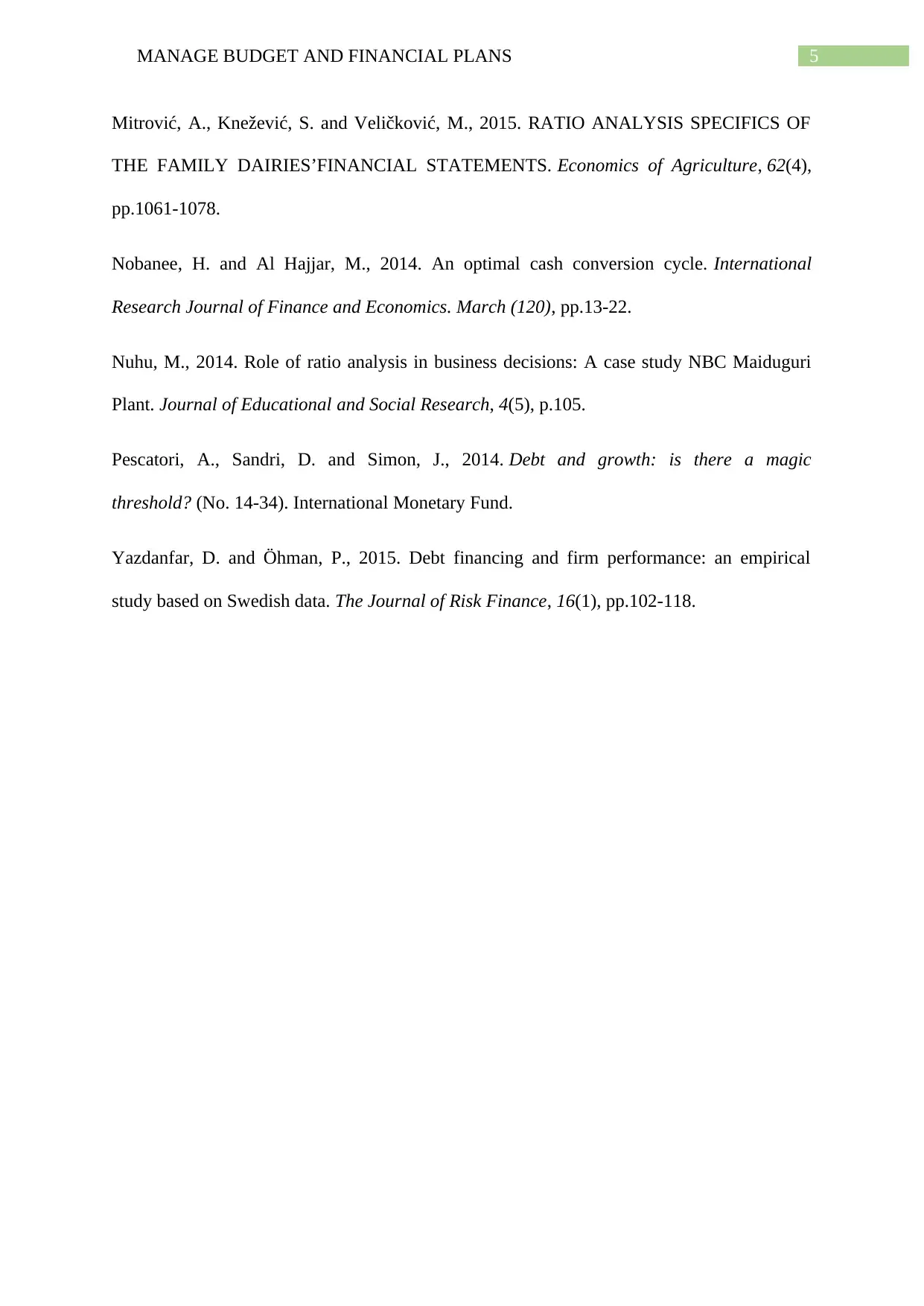
5MANAGE BUDGET AND FINANCIAL PLANS
Mitrović, A., Knežević, S. and Veličković, M., 2015. RATIO ANALYSIS SPECIFICS OF
THE FAMILY DAIRIES’FINANCIAL STATEMENTS. Economics of Agriculture, 62(4),
pp.1061-1078.
Nobanee, H. and Al Hajjar, M., 2014. An optimal cash conversion cycle. International
Research Journal of Finance and Economics. March (120), pp.13-22.
Nuhu, M., 2014. Role of ratio analysis in business decisions: A case study NBC Maiduguri
Plant. Journal of Educational and Social Research, 4(5), p.105.
Pescatori, A., Sandri, D. and Simon, J., 2014. Debt and growth: is there a magic
threshold? (No. 14-34). International Monetary Fund.
Yazdanfar, D. and Öhman, P., 2015. Debt financing and firm performance: an empirical
study based on Swedish data. The Journal of Risk Finance, 16(1), pp.102-118.
Mitrović, A., Knežević, S. and Veličković, M., 2015. RATIO ANALYSIS SPECIFICS OF
THE FAMILY DAIRIES’FINANCIAL STATEMENTS. Economics of Agriculture, 62(4),
pp.1061-1078.
Nobanee, H. and Al Hajjar, M., 2014. An optimal cash conversion cycle. International
Research Journal of Finance and Economics. March (120), pp.13-22.
Nuhu, M., 2014. Role of ratio analysis in business decisions: A case study NBC Maiduguri
Plant. Journal of Educational and Social Research, 4(5), p.105.
Pescatori, A., Sandri, D. and Simon, J., 2014. Debt and growth: is there a magic
threshold? (No. 14-34). International Monetary Fund.
Yazdanfar, D. and Öhman, P., 2015. Debt financing and firm performance: an empirical
study based on Swedish data. The Journal of Risk Finance, 16(1), pp.102-118.
⊘ This is a preview!⊘
Do you want full access?
Subscribe today to unlock all pages.

Trusted by 1+ million students worldwide
1 out of 6
Related Documents
Your All-in-One AI-Powered Toolkit for Academic Success.
+13062052269
info@desklib.com
Available 24*7 on WhatsApp / Email
![[object Object]](/_next/static/media/star-bottom.7253800d.svg)
Unlock your academic potential
Copyright © 2020–2025 A2Z Services. All Rights Reserved. Developed and managed by ZUCOL.





